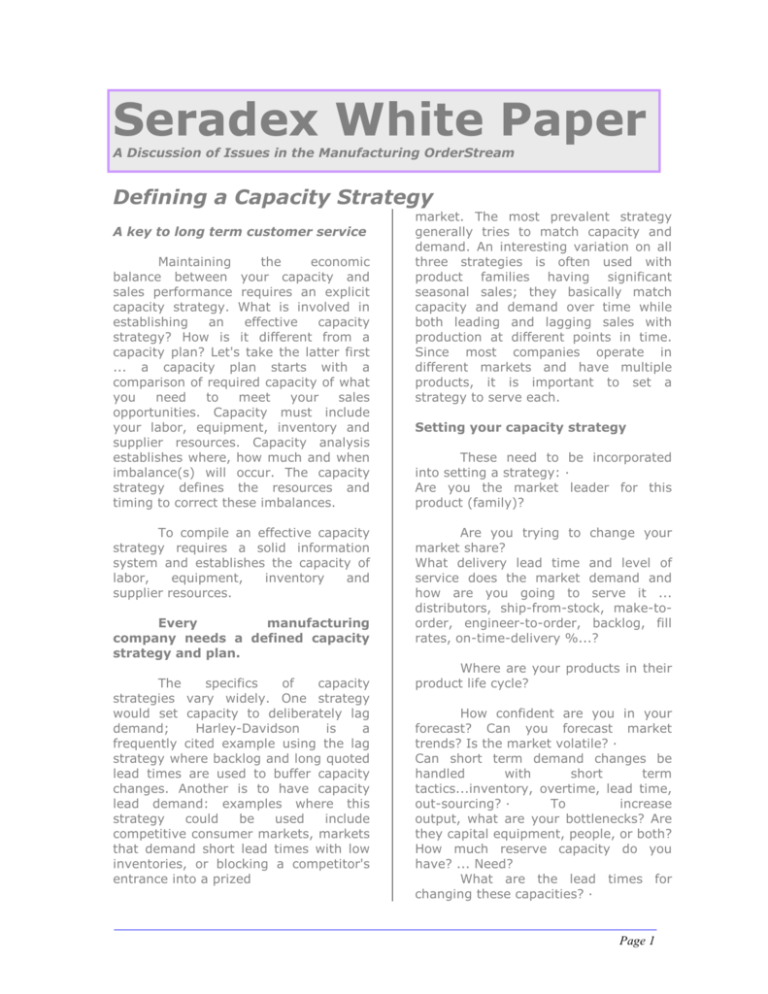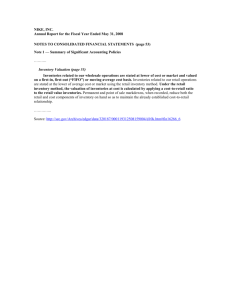Capacity Strategy
advertisement

Seradex White Paper A Discussion of Issues in the Manufacturing OrderStream Defining a Capacity Strategy A key to long term customer service Maintaining the economic balance between your capacity and sales performance requires an explicit capacity strategy. What is involved in establishing an effective capacity strategy? How is it different from a capacity plan? Let's take the latter first ... a capacity plan starts with a comparison of required capacity of what you need to meet your sales opportunities. Capacity must include your labor, equipment, inventory and supplier resources. Capacity analysis establishes where, how much and when imbalance(s) will occur. The capacity strategy defines the resources and timing to correct these imbalances. To compile an effective capacity strategy requires a solid information system and establishes the capacity of labor, equipment, inventory and supplier resources. Every manufacturing company needs a defined capacity strategy and plan. The specifics of capacity strategies vary widely. One strategy would set capacity to deliberately lag demand; Harley-Davidson is a frequently cited example using the lag strategy where backlog and long quoted lead times are used to buffer capacity changes. Another is to have capacity lead demand: examples where this strategy could be used include competitive consumer markets, markets that demand short lead times with low inventories, or blocking a competitor's entrance into a prized market. The most prevalent strategy generally tries to match capacity and demand. An interesting variation on all three strategies is often used with product families having significant seasonal sales; they basically match capacity and demand over time while both leading and lagging sales with production at different points in time. Since most companies operate in different markets and have multiple products, it is important to set a strategy to serve each. Setting your capacity strategy These need to be incorporated into setting a strategy: Are you the market leader for this product (family)? Are you trying to change your market share? What delivery lead time and level of service does the market demand and how are you going to serve it ... distributors, ship-from-stock, make-toorder, engineer-to-order, backlog, fill rates, on-time-delivery %...? Where are your products in their product life cycle? How confident are you in your forecast? Can you forecast market trends? Is the market volatile? Can short term demand changes be handled with short term tactics...inventory, overtime, lead time, out-sourcing? To increase output, what are your bottlenecks? Are they capital equipment, people, or both? How much reserve capacity do you have? ... Need? What are the lead times for changing these capacities? Page 1 What are the costs and benefits of implementing a capacity change? ... Of not implementing a capacity change? What guidelines should be followed when changing capacities ... flexibility, quick change, technology...? In what products should capacity lead demand? ... Lag? ... Be balanced? The answers that determine the strategy can vary with the passage of time making it necessary to periodically review your strategies. This is routinely part of the annual formal strategic planning process and the closely allied business planning process. Once you strategies have determined your Review them for conformance. This occurs during the monthly sales and operations planning (S&OP) process. In S&OP, top operational management monitors the month-bymonth capacity plans for critical capacities where real and potential problems exist. As fresh operational and tactical decisions are made each month, the capacity plan gets executed or the need to review the strategy becomes apparent. 4 - Excellent - very high level results are being achieved from performing this activity. 3 - Very Good - fully performing this activity but additional improvements are attainable. 2 - Good - Most of the needed processes and/or tools are in place; not fully utilizing them but additional goals are being worked on. 1 - Fair - People, processes, data, and/or systems are not in place; few if any goals have been achieved but they are being worked on. 0 - Not Doing - This is required but no goals are being pursued and/or no one is working on getting the people, processes, data and/or systems in place. Overview Question There is a defined strategy for maintaining an economic balance between plant capacity and sales performance. There is a regular management review to insure that capacity is being managed to support these strategies. Detail Questions Assessing your capacity strategies Put a small team together to assess your capacity strategies. To aide you in assessing the effectiveness of your capacity strategy processes, we have provided overview question #6 Capacity Strategies along with its associated detailed questions from our Operational Excellence Checklist. To assess the effectiveness of your capacity strategies, score your processes using the following scoring system: Use the following detailed questions to arrive at an assessment of your Inventory Strategies: A capacity strategy and plan exists for each product family and is updated on a regular basis as an integral part of the S&OP process. Capacity levels are managed in the aggregate through the S&OP process. There is a management consensus on the plant capacity and it is measured in appropriate units of measure. Page 2 Financial input to strategic decisions involving capacity investments is based on close analysis of the cost drivers and return on investment with respect to the products to be produced. Rough-cut capacity planning, or its equivalent, is used to evaluate the impact on critical resources of alternative production and master production schedule plans. "Off-load" strategies and suppliers are in place. (If you aren't sure what this means, read the companion article in this newsletter on Developing a Capacity Plan ....) There is a regular review of product engineering and development needs for manufacturing processes and capacities. This review also includes the introduction of new technology. A periodic review is performed to determine what levels of inventory are being carried to either "bank" capacity or minimize setups. Examples include inventory due to lot sizing, safety stock, seasonal build, build ahead, etc. Continuous improvement processes are being used to reduce setups and thereby increase capacity available for production. There is available machinery, equipment, and manpower resources to support a short term increase in sales volume without additional expenditures for facilities or equipment. There is management consensus on the amount of increased sales that can be handled. There is a capacity utilization and reporting system that tracks and reports actual up/down time, production rates by product, and problem areas for application of continuous improvement or for new equipment purchase. Assessment of Results If you scored ‘3 - Very Good’ or better on the overview question as well as most detailed questions, great! You’re certainly doing better than most at defining and maintaining an inventory strategy. Scores of ‘2- Good’ or less deserve a further look. You may be leaving dollars, customer service and competitive opportunities on the table. If you find widely diverse opinions within your team, find out why. More often than not, there’s an understanding gap and a possible education need to be addressed. Summary The high costs associated with large rolling past dues, excessive inventories, customer's leaving, expediting, quality problems, costs out of control ... these can more often than not be traced back to capacity problems. Setting and understanding your capacity strategies supported by good capacity planning tools and data is paramount to managing a manufacturing company. Two types of companies ... those where management views pro-active capacity management as key and regularly spends time involved with it versus companies where senior management only becomes involved with capacity from crises to crises. Which company are you? Seradex Inc. 4460 Harvester Rd. Burlington, ON L7L 4X2 Tel: 905-332-5051 mcorker@seradex.com www.seradex.com Page 3











